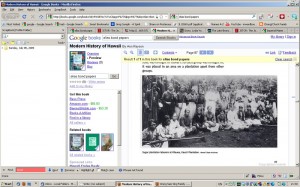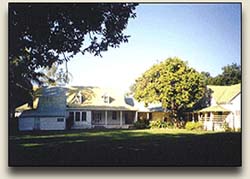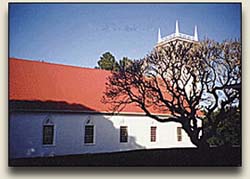Found this on Coffeetimes. Just a history of Elias Bond who Wung Sam Sing had worked for on his taro patch? and Sugar Plantation.
http://www.coffeetimes.com/aug98.htm
Tides of a Mission
by Veronica S. Schweitzer
| Reminiscent of New England architecture the Bond Mission Station is now a historic landmark in North Kohala |
Isolated from the bustling activity elsewhere on the islands, in rugged silence perturbed only by unpredictable storms and heavy rains, North Kohala proudly sails the waves of struggle and prosperity.
The road ends here. It doesn’t require great imagination to sense, in Kohala’s buildings, people, and land, how challenges and demands color the sweetness and inspiration of a remote, rural area. Yet all what Kohala is about today has been shaped by a most unusual, often difficult, past: A New England Mission Station, independent and self-sufficient, transformed Kohala so people found both the work and inspiration to stay, at a time that the future for many Hawaiians had turned bleak.
On Highway 270, past Hawi and Kapaau, a simple green and white sign refers to the Bond Historic District, where once the ‘Iole Mission Station started and expanded to meet the needs of the growing community it served. Today’s driveway to the Bond Estate leads through a large macadamia nut orchard, pockmarked with the rooting damage of wild, hungry pigs. The first buildings one sees, edging a small courtyard, are locked up, and in need of serious repair. A black stonewall, strengthened with coral mortar, encircles a garden and orchards behind. In it is a gate, the opening no taller than five and a half feet. The pathway from that gate leads to the bedroom in the oldest house. Imagine roses growing over that wall, and orange blossoms on the path. Imagine Ellen Bond, wife of Kohala’s missionary Elias Bond, minute at 4’10”, as she tends the garden, bakes her bread, teaches a home school for girls, and raises no less than nine little Bonds in a tropical land far from New England, in culture and in distance.
The first missionaries arrived on the islands in 1820. They found a nation that had just lost the foundation of its religious values with the abolition of the ancient taboos. Hawaii was hungry for renewed security and order. The missionaries, as it happened, found fertile grounds.
At least 8000 people lived in Kohala at the time. They were taro farmers and survived with the abundance of ocean and land. Missionaries occasionally tried out this harsh corner of the islands, but saw no point in regularly risking their lives on Kohala’s precipitous cliffs. Poverty, the lack of medical care, and isolation scared them away.
In 1837, Kohala finally received some solid support. A first thatch church was built at Nunulu, above Kapaau town. Two years later, a brave missionary, Reverend Bliss, built himself a small house and laid the foundation of the ‘Iole Mission Station, what is now the Bond estate. The harsh conditions drove him insane within a couple of years.
In 1840, minister Elias Bond, a former hatter and teacher, left Hallowell in Maine, to make Hawaii his home with his wife Ellen. They were in their mid-twenties, devoted to each other, and devoted to placing their lives in the service of their God. Kohala needed someoneŠ. The young Bonds moved into the ‘Iole Mission.
Schools
Questionable as the work of missionaries might seem today, a century and a half ago this group of men and women thoroughly believed in the beauty of their cause. Hawaii at the time reached the highest level of literacy in the world, greater than 90 percent of the population. Elias Bond, among all missionaries, was probably the strongest proponent for schools throughout the islands.
He taught, for sure. Even so, he opened himself to learn from the Hawaiians, deeply impressed with their practical methods of teaching, which included astronomy, botany, and canoe building. Bond’s tradition had always restricted itself to the three R’s, reading, writing, and arithmetic, nothing that seemed very useful in a country demanding plain survival skill. He was painfully aware of the lack of understanding from white man toward Hawaiian people and noted in one of his journals how the Hawaiians studied “the open book of nature”, while the white man didn’t look beyondthe surface of “barbarism.”
Most of his years of service, he stood alone, wanting so many things for his congregation which the Mission Board could not afford. At a time that many missionaries returned home and there was no funding left at all, Bond refused to give up, and had to find ways to secure financial independence.
In the first year of his mission, Bond opened the Teachers’ School at his homestead to train people for the 32 school houses he would eventually scatter around the district. The following year he opened the Select Boys’ Boarding School. The boys lived on the property. While Bond taught the basics of reading and writing, he learned to speak fluent Hawaiian within a couple of years. Ellen started a girls’ school at home, teaching up to 40 girls. Because of her own growing family, she was forced to let go. In 1874 an official Girl School, always Ellen’s dream, finally opened on the ‘Iole Estate. The first principal, Miss Lyons, traveled from Waimea, and made sure the girls did all their own cooking and washing. They prepared a full ground oven twice a week for their taro, and went on long hikes in the mountains . The school grew so popular that it was forced to expand into additional buildings.
Bond hiked to ahupua’a (land divisions) deep in the valleys and did all religious services in Hawaiian, including those on the Estate where small Kalãhikiola Church welcomed over 1200 people most weeks.
Kalãhikiola Church, the most important building for the mission, had to be built five consecutive times before it finally stood on solid ground. It had started out as the thatch halau at Nunulu. Reverend Bliss removed it to ‘Iole in 1840, and Bond rebuilt it a couple of times with more grass. Rains and storms ravaged the little shack and Kohala committed itself to the erection of a church made of timber carried ten miles down from Kalãhikiola hill where trees could be hewed. It took three years before the church saw completion, only to be ruined four years later in a harsh Kona gale. As it turned out, one of the carpenters had neglected to attach pins to the beams.
“With the help of God and without aid of any other kind”, as he said, Bond and his people dedicated themselves to the construction of a stone church. The work took five years. Stones had to be gathered from nearby gulches and carried on shoulders and backs. Lime had to be drawn up from the depths of the ocean attached to dangerous coral clumps. There were no animals to help. The Church finally opened on October 11, 1855, and there again, all meetings, prayers and chants were in the Hawaiian language.
When in later years an English Church was needed for the influx of foreigners, it was built outside of the ‘Iole Estate, in 1869, and Bond called it the “Foreign Church.”
The Plantation
Elias Bond settled into a crowded Kohala. But the privatization of land and newly imposed land taxes forced many Hawaiian families to move away in search of jobs. By the early 1860’s, Bond’s “flock” had dwindled to less than 3000 people. There was no money in Kohala. The Mission Board officially pulled out in 1855: No aid could come from there. It was Bond’s choice to keep on working, alone.
Bond had tried for years to think of ways that he could buy the increasing amount of abandoned land and pioneer a healthy agriculture. He wanted to change the ebbing tide and induce people to stay. At last he acquired the 200 plus acres of the ‘Iole Mission and he suddenly realized the answer: “Finally,” he wrote, “it came to me(Š) (that the) Sugar Plantation is the only possible way of retaining people in Kohala. There was no work in the district otherwise by which our people could earn a dollar. This was the sole motive that led to the establishment of Kohala Sugar Plantation.”
Bond attracted Castle & Cooke as agents, and by 1863 sugar grew everywhere. The nickname became “Missionary Plantation”, and it was predicted to not even last beyond five years.
Those were tumultuous years. Sugar plantations across the islands were thriving on cheap labor and slave-like conditions. Bond had no secular interests, although of course he wanted success for the plantation. His interest was that people stayed, with good morals, for the Church, for the land they loved. Where then was the line between showing up for work, as the managers demanded, or showing up for God, as Bond wished? There was great anxiety in terms of debts and disagreement over management. For plantation laborers, life was hard.
Yet Kohala came through: By the early 70’s, the Kohala Sugar Plantation handed Bond a profit of $48,000. He gave the money to schools, and to the Mission Board. The Plantation was thriving at last.
(Bond would not live to see the construction of the Kohala Ditch in 1904, the ditch that brought prosperity to Kohala as it had never seen before and hasn’t seen since. It was the ultimate crowning for the Plantation and with the new wealth Hawi and Kapaau expanded with the buildings we see today. The Sugar Plantation officially closed in 1975.)
Change
Ellen Bond, indispensable to the work of her husband, died in 1881, at the age of 64. Bond never quite recovered from the loss. On August 19, 1884, he handed his work over to S. W. Kekuewa, a Hawaiian pastor. Bond was 71 years old, too old for strenuous hikes and quarterly tours of the district. He continued serving till his death in 1896, assisted by two of his daughters, Caroline and Julia. Elias Bond had worked with the people of Kohala for 55 years.
The Bond Homestead saw one more addition around that time, when Benjamin D. Bond settled as Kohala’s doctor in 1884. He married Emma Renton in 1889. The landscape was enhanced by a pond for hydrotherapy, no less, as well as other sheds and buildings to accommodate new machinery.
But the last Bonds left the homestead in the late 1930s. The houses gradually fell into decay. Inside them there is still the koa furniture, the lauhala mats, Bond’s old desk, Ellen’s round table, and a wooden chest for travel overseas.
The estate fell under management of ten remaining Bond cousins, in what they named the ‘Iole Development Corporation. But from far away and with different interests, decision making has been difficult. The empty buildings deteriorated fast. To ensure good maintenance of the church, one acre was given away, and in the midst of the ruined houses Kalãhikiola still stands, a proud example of careful preservation.
Twenty-five years ago, in 1973, a major earthquake damaged the buildings on the Bond Estate. A chain of small tremors caused large cracks in the old stone walls. The church was restored once again, costing $40,000 in repairs, five times the original cost. The Bond Homestead was forced to close its doors, since no one was living there any more. The girls school, while it had remained active through 1956, turned into a flophouse for transient people, and no one seemed to care.
Today
Boyd D. Bond, fifth generation, and great-great grandson of Elias, has moved back to the Estate and is giving tours of the land and the buildings. He has established a non-profit status for the district, under the name Ho’omau O ‘Iole (Preserve ‘Iole). His dream is that the old buildings can be restored, a museum perhaps for the homestead, a unique bed and breakfast where the girls’ school stands. Lei gardens. As a historic district, the land is for sale.
Boyd knows that this New England-style mission is unique and must be preserved, that it’s the only mission in the Pacific still intact with all the buildings just as they were a 150 years ago. One historian, he says, has called it one of the six most important historical sites in Hawaii. It was included on the National and State Registers of Historic Places in 1977 and 1978.
Kohala still lies in rugged isolation, and the quaint buildings which now give shelter to little boutiques, coffee shops and restaurants, where new foreigners are hoping to make an old community thrive once again, speak of the missionary era, of Ellen and Elias Bond. They still point to that green and white sign on the road, from where it all started. The Bond estate is open for daily tours. For more information, call 889-0883.
“Readers may submit editorial comments to any of our stories by sending an email to [email protected]. We would be happy to attach your comments and feedback to anything we publish online. Thank you for your interest.”:
Story appeared originally in Coffee Times print magazine and appears online for archival purposes only. Any use or reprinting of these stories without the expressed written consent of the author is prohibited.



